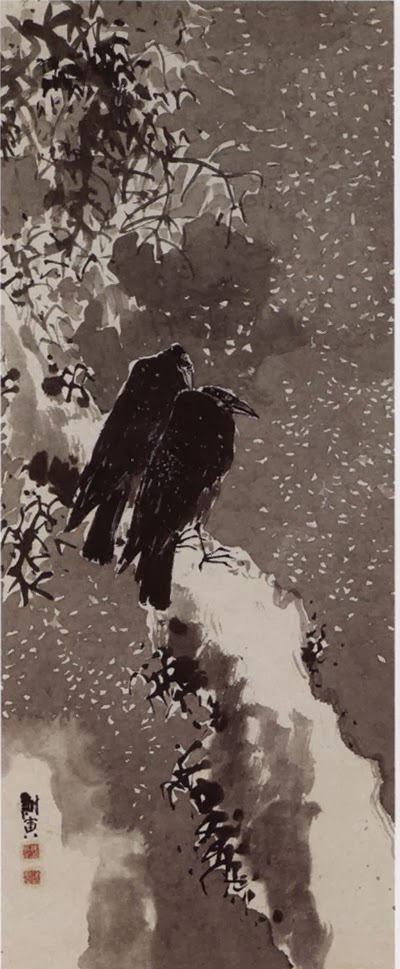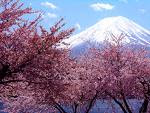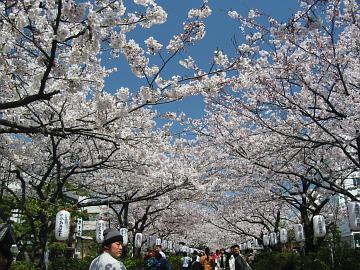:::::::::::::::::::::::::::::::::::::::::::::::::::::::::::::::::::::::::::::::::::::::::::::::::::::
Cleaver weeds (mugura)
***** Location: Japan
***** Season: Various, see below
***** Category: Plant
*****************************
Explanation
The Japanese word mugura comprizes a variety of creepers and grasses, mostly of the family Rubioidea (akane) アカネ属 and yae-mugura ヤエムグラ属 .
akane mugura アカネムグラ(茜葎) Rubia jesoensis

the yae-mugura family ヤエムグラ属
. . . CLICK here for Photos !
yae mugura ヤエムグラ(八重葎) Galium spurium, var. echinospermon
..... false cleavers; Marin County bedstraw, Catchweed, Stickywilly
togenashi yae mugura トゲナシヤエムグラ Galium spurium (yae-mugura without thorns)
kuruma mugura クルマムグラ(車葎) Galium japonicum
yabu mugura ヤブムグラ(藪葎) Galium niewerthii (mugura in the thickest)
kuriibaazu クリーバーズ "cleavers", Galium aparine, goose grass.
. . . CLICK here for Photos !
Its leaves can be used for herb tea.
the futaba-mugura family フタバムグラ属
futaba mugura フタバムグラ(双葉葎) Hedyotis diffusa
the asa (hemp) family アサ科(あさか、麻科、Cannabaceae)
kana mugura カナムグラ(鉄葎) Humulus japonicus
Here I choose CLEAVERS to refer to mugura.
I have them as permanent visitors in my garden, in a constant fight during the summer months. Their vitality is amazing!
Cleaver is a kind of weed which sticks to everything, grows so quickly even up trees in a forest or among shrubs. It needs to support itself on another plant or building.
:::::::::::::::::::::::::::::::::::::::::::::::::::::::::::::::::::::::::::::::::::::::::::::::::::
Galium aparine
is a herbaceous annual plant of the family Rubiaceae. It is native to North America and Eurasia. It has several common names, including Cleavers, Clivers, Goosegrass, Stickywilly, Stickyweed, Catchweed, Robin-run-the-hedge and Coachweed.
The long stems of this climbing plant sprawl over the ground and other plants, reaching heights of 1-1.5 m, occasionally 2 m.
It is a common weed in hedges and other low shrubby vegetation, and is also a common weed in arable fields, as well as gardens. As they grow quite rampantly and thickly, they end up shading out any small plants that they overrun.
© More in the WIKIPEDIA !
:::::::::::::::::::::::::::::::::::::::::::::::::::::::::::::::::::::::::::::::::::::::::::::::::::::
kigo for all summer
mugura 葎 (むぐら) cleavers
..... mogura もぐら
kana mugura 金葎(かなむぐら) 鉄葎 Humulus japonicus
yae mugura 八重葎(やえむぐら)Galium spurium
yotsuba mugura 四葉むぐら(よつばむぐら)cleavers with four leaves
yama mugura 山むぐら(やまむぐら)"mountan cleavers"
hana mugura 花むぐら(はなむぐら)"cleaver blossoms"
kiku mugura 菊むぐら(きくむぐら)"chrysanthemum cleavers"
kusa mugura 草むぐら(くさむぐら)"weed cleavers"
. mugura no kado 葎の門(むぐらのかど)
gate covered with cleavers
mugura no yado 葎の宿(むぐらのやど)lodging covered with cleavers
mugura shigeru 葎茂る(むぐらしげる)cleavers growing thick
mugura u 葎生(むぐらう)cleavers are growing
.................................................................................
kigo for all autumn
tsuyu mugura 露葎(つゆむぐら)dew on the cleavers
.................................................................................
kigo for all winter
karemugura, kare mugura 枯葎 (かれむぐら)
withered cleavers
*****************************
Worldwide use
*****************************
Things found on the way
*****************************
HAIKU
. Matsuo Basho 松尾芭蕉 - Archives of the WKD .

yamagatsu kuhi memorial stone
山賤(やまがつ)のおとがひ閉る葎かな
yamagatsu no otogai tozuru mugura kana
the poor woodcutters
have to keep their mouths shut
because of the cleaver weeds . . .
Tr. Gabi Greve
at Tanimura in Oshu, Yamanashi 甲州谷村
Oshu is another name for the Kai province 甲斐. Written in 貞亨2年, Basho age 43.
. Matsuo Basho 松尾芭蕉 - Nozarashi 野ざらし紀行 .
(otogai is the lower jaw, in old times also used for mouth)
The forest workers and hunters of old were rather taciturn anyway.
This hokku has the cut marker KANA at the end of line 3.
I see this as plural, since there were usually many forest workers together doing the dangerous job of cutting wood (whith the tools of the Edo period) and transporting it out of a forest. Here we can imagine them finding their way through the thick sticky weeds, and their chattering is disrupted by the silence, trying to keep them out of their mouths. It it was only one, he would probably not be talking to himself and have his mouth shut anyway.
MORE ABOUT
. yamagatsu (forest workers, woodcutters)
"lumberjack", "woodsman," "mountaineer," "hillbilly."
...........................................
the woodcutter
keeps his mouth closed
tall bed-straw grass
Tr. Jane Reichhold
Comment
1685--summer. The grass called 'mugura' is of the Galium family and is sometimes called "bedstraw" or "goose-foot" grass. The grass could grow as tall as a person's chin.
Larry Bole coments:
So, what was so remarkable about this "woodcutter" that caught Basho's attention? Were they notorious chatterboxes, so that Basho noted that the tall grass shut one up, from not wanting to get grass in his mouth as he talked and talked?
Read a discussion of this haiku translations
by Larry Bole, Haiku Translation Forum
Translation by Oseko Toshiharu
haiku #219 of Volume 2, found on p. 116 of that volume.
A woodcutter's mouth
Is closed firm walking through
The bush of bedstraws!
and his notes
yamagatsu = kikori: a woodcutter or = kariduo: a hunter living in the mountain
otogai: the lower jaw, a mouth
tozuru (rentai) <- tozu (kami-ni, vi.) = tojiru (mod J): to close, shut mugura = yaemugura: a bedstraw, Galium spurium L. var. echinospermom Hayek "" : a cleavers, Galium aparine (goose grass) Galium has about 400 varieties in the world, and 19 varieties in Japan. Mugura is a plant growing wild as tall as the position of someone's lower jaw. This deftly corresponds to the firmly closed mouth of the woodcutter. The preface reads: In the mountain of Kai Province. Listed source is Zoku Minashi-guri: a selection of haikai, compiled by Kikaku, published in 1687.
external Japanese LINK
Basho in Kai province
續虚栗集 collection of poetry
葎 . . やえむぐらなど、繁茂してやぶをつくるつる草の総称》
mugura, name for yaemugura and others.
http://sky.geocities.jp/hokurekihakusyu/kaibasyou.html
..........................................................................
More from Matsuo Basho and the cleavers
. Matsuo Basho 松尾芭蕉 - Archives of the WKD .
さしこもる葎の友かふゆなうり
sashikomoru mugura no tomo kabuna uri
Staying indoors,the only friend
At the house of the bedstraw is
The vendor of winter greens!
Tr. Oseko Toshiharu
are you a companion
to those creepers secluded away?
winter vegetable seller
trans. Barnhill
Barnhill's comment:
Winter: winter greens. 1688-89. Basho is living in winter seclusion, with no visitors and his hut covered with creepers. Farmers would walk around selling the meager winter vegetables, such as Chinese cabbage. A scene of a someone living secluded in humble circumstances.
staying indoors
the only friend of bedstraw
a vendor of greens
trans. Reichhold
Reichhold's comment:
1688--winter. Bedstraw, also called goosegrass ('Galium spium'), was used to stuff mattresses for the poor. In winter, Basho has two reliable friends to keep him well, and both were green plants.
* * * *
Is Reichhold suggesting that Basho's futon is stuffed with bedstraw?
And that Basho is using "bedstraw" as a figure of speech to mean himself?
Ah, if only Basho had used 'fuyugomori' (winter seclusion) instead of 'sashikomoru' (staying indoors), it would make the translation somewhat easier, in my opinion. "Staying indoors" begs the question of who is staying inddoors. Barnhill cleverly works around this by saying it's the creepers that are "secluded away." I think we are to take it to mean that Basho is identifying himself with the creepers.
And I would use "peddler" rather than "vendor," since vendors can have stalls, and don't necessarily sell their wares going door-to-door.
. . Discussion by Larry Bole
more haiku with sashikomoru
The history of the futon in the Edo period
keeping warm with what you have ...
. WKD : winter seclusion (fuyugomori)
bedtime quilts (yogi) and more
.................................................................................
葎さへ若葉はやさし破れ家
(むぐらさへわかばはやさしやぶれいへ)
mugura sae wakaba wa yasashi yabure ie
even the creepers:
their new leaves lovely
at the dilapidated house
trans. Barnhill
Spring: new leaves on creepers. 1689.
Someone is away serving the Shogun in Edo.
* * * *
even bedstraw
has tender new leaves
a dilapidated house
trans. Reichhold
1689--spring.
Shikin (1673-1735), a warrior of the Oogaki Clan, asked Basho to write a haiku on the painting of a ruined house. At this time, Basho was preparing to sell his home, and nothing looks more dilapidated than a house one wants to sell.
.................................................................................
芋植ゑて門は葎の若葉かな
いも植て門は葎のわか葉哉
imo uete kado wa mugura no wakaba kana
they planted taro potatoes -
at the gate the mugura creeper
shows its new leaves
Tr. Gabi Greve
Written in 1688 貞享五年 / 元禄元年, Basho age 45.
At temple Ooedera 大江寺 Oedera, Nabari town, Mie 名張市. The temple was surrounded by taro potato fields, planted by his host, but the weeds were much stronger.
The temple was later destroyed by fire and now a stone memorial reminds of its existence.
To talk about planted food and weeds together shows the kind of fuuryuu 風流 elegance Basho wants to bring to his poetry.
At the kukai meeting in 草庵、二乗軒 二畳軒 in Ise.
There is also a version with "camellia in the bushes"
藪つばき 門はむぐらの若葉かな
藪椿門は葎の若葉哉
yabutsubaki mon wa mugura no wakaba kana
. Oi no Kobumi 笈の小文 .
. Matsuo Basho 松尾芭蕉 - Archives of the WKD .
:::::::::::::::::::::::::::::::::::::::::::::::::::::::::::::::::::::::::::::::::::::::::::::::::::::
Kobayashi Issa 一茶
has quite a few haiku on the mugura, often combined with other season words.
David Lanoue writes :
In an earlier version I rendered mugura as "goose-grass," but I now believe that its sense is more correctly conveyed as "weeds." The plant is mugura, which some translators render as "goose-grass." Maruyama Kazuhiko defines it simply as zassô, "weeds".
竹の葉につれて葎もわか葉哉
take no ha ni tsurete mugura mo wakaba kana
keeping bamboo shoots
company, weeds
fresh green too
Issa, translated by David Lanoue
..........................................................................
. WKD : Kobayashi Issa 小林一茶 in Edo .
夕立の拍子に伸て葎哉
yuudachi no hyooshi ni nobite mugura kana
to the rhythm
of the downpour creepers
longer already
Tr. Chris Drake
This hokku is from the 6th month (July) of 1819, the year evoked in Year of My Life. Judging from its placement in Issa's diary, it was written a few days before the death of Issa's infant daughter Sato on 6/21.
A sudden rain or thunderstorm is passing through, probably late in the afternoon on a hot summer day. The storm doesn't last long, but it is a squall, probably with strong wind as well as heavy rain. Even before the rain is finished, however, the fast-growing wild vines invading the garden seem to have grown even longer than they were a few minutes before. The strength of the rain has given these wild plants even more energy as they try to cover the entire garden. Mugura is a general term, not the name of any one type of herb weed, and the nomenclature changed a bit during modernization.
Today mugura most commonly refers to cleavers and other members of the madder family, but in Issa's time it most commonly referred to Japanese hop (Humulus japonicus), a fairly stiff vine with small hook-like prickles on it that creeps, climbs, and twines around other plants, literally choking them. It also clings to walls and houses and can quickly grow to 3-6 m. high, so it is considered quite invasive. Probably this is the weed Issa is watching in the hokku, though it could be cleavers or a similar plant.
In Issa's vision, the weed vine, somehow sensing the intensity of the pouring rain, seems to gain renewed strength, increasing in length almost immediately in response to the surge of energy it is getting from the rain. The hokku seems to be about how the plant reacts to its environment and about its apparent ability to feel the rhythm of the rain, apparently gaining energy from this powerful rhythm. Issa also seems to feel danger in the energy coming from the rhythm of the rain and the aggressive weeds. Could it be because the strength of the weeds is almost the precise opposite of the increasing weakness shown by his baby daughter?
Chris Drake
:::::::::::::::::::::::::::::::::::::::::::::::::::::::::::::::::::::::::::::::::::::::::::::::::::::
 金色の小鳥飛び立つ枯葎
金色の小鳥飛び立つ枯葎kin-iro no kotori tobitatsu kare mugura
a golden-colored
small bird flies off . . .
withered cleavers
source : hamahide44
*****************************
Related words
***** . mogura-uchi 土龍打 ( もぐらうち) "hitting the moles" .
:::::::::::::::::::::::::::::::::::::::::::::::::::::::::::::::::::::::::::::::::::::::::::::::::::::
[ . BACK to DARUMA MUSEUM TOP . ]
[ . BACK to WORLDKIGO . TOP . ]
:::::::::::::::::::::::::::::::::::::::::::::::::::::::::::::::::::::::::::::::::::::::::::::::::::::



























